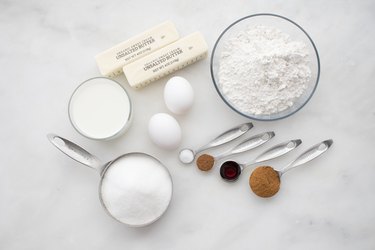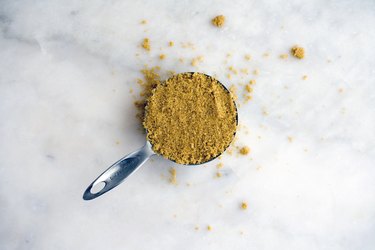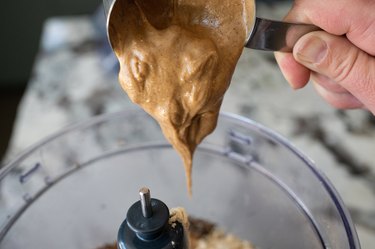
Recipes rely on the use of accurate measurements, especially in baking, so knowing how to correctly measure 2/3 of a cup is necessary to achieve the desired outcome — think perfectly moist muffins or delightfully fluffy pancakes. And if you're in the middle of baking a batch of cookies and your 2/3 measuring cup is nowhere to be found, it is helpful to know measurement conversions so that your recipe turns out just right. Different types of ingredients are measured differently. Let's go over how to measure 2/3 of a cup in dry ingredients, wet ingredients, and sticky ingredients, like honey or molasses.
How Do I Measure 2/3 Cup of Butter?
Sticks of butter typically come packaged with markings that show tablespoons. A stick of butter equals 8 tablespoons. If you need 2/3 of a cup of butter, use 1 whole stick of butter, plus approximately 3 tablespoons from another stick.
Video of the Day
Dry Ingredients

Measure dry ingredients, including flour, sugar, nuts, and chocolate chips, using measuring cups, which are often made of plastic or metal.
Video of the Day
To accurately measure 2/3 of a cup of dry ingredients like flour and sugar, overfill the measuring cup and then sweep a spatula handle, butter knife, or other utensil with a flat handle across the top of the cup to remove the excess, so that you're left with a perfectly full measuring cup. Sweep the leftover ingredients back into the container you got them from so that nothing goes to waste.
For coarser ingredients like nuts or chocolate chips, jiggle the measuring cup to settle the pieces, then use your best judgment to determine if the cup is approximately full, adding or removing pieces as needed.
You may also want to double-check the recipe. If it references a "generous" or "heaping" cup, then that means you don't need to level off the measurement. Keeping a little extra on top is fine.
Ingredients like flour or sugar are essential in baking recipes, so using this method will allow you to get the proper proportions of each. Mix-ins, like nuts and chocolate chips, are slightly less important to the chemistry of the bake, so don't stress out over them.
Tip
Use a 1/3 of a cup and fill it twice if you don’t own or can’t find your 2/3 measuring cup. You can also use 10 tablespoons plus 2 teaspoons in a pinch as a conversion for 2/3 of a cup.
Sticky Ingredients

Ingredients such as molasses, honey, or peanut butter, while not technically dry ingredients, should also be measured with plastic or metal measuring cups. When measuring these types of sticky ingredients, you can use a flat edge to level off an over-full cup, or for stickier ingredients, feel free to eyeball it to make things easier. Set the cup on a flat surface and position yourself with a line of sight that is level with the top of the measuring cup. You want the ingredients to be approximately level across the top.
Tip
Thinly coat the inside of your measuring cup with oil (olive oil, vegetable oil, or butter works) before measuring sticky ingredients. After you've measured the ingredient and you're ready to dump it in your mixing bowl, the oil will cause everything to slip out cleanly without you having to work everything out with your fingers.
Liquid Ingredients

Liquid ingredients are measured using liquid measuring cups, which are often made of plastic or glass and come in sizes like 4 or 8 cups. Most include a 2/3 cup measurement marking. To accurately measure a liquid ingredient, like water, olive oil, or soup stock, slowly pour it into a liquid measuring cup that is set on a flat surface. As you approach the 2/3 cup line, position yourself so that you are eye-level with the marking. Due to the surface tension of liquids, the surface does not sit perfectly flat. If forms a meniscus, which appears as a slight curve, slowly continue adding your liquid to the measuring cup until the bottom of the meniscus is perfectly level with the bottom of the 2/3 cup marking.
Tip
In a pinch, you can use 10 tablespoons plus 2 teaspoons as a conversion for 2/3 of a cup, but it might not be as accurate. Rest the spoon on a flat surface and level your sight with the top of the spoon to make sure the liquid isn’t curving too far under or over the top of the spoon after you pour it in.